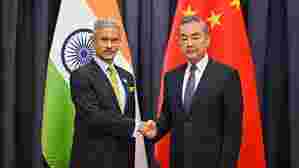The India and China Relations is often described as a mix of conflict, competition, cooperation, and containment — capturing the deeply ambivalent and evolving nature of their engagement. Over the past decade, strategic, economic, and political dynamics have made this bilateral relationship increasingly complex and unpredictable.
This article explores the major themes shaping India–China relations today — highlighting tensions, paradoxes, and possible future directions.
Recent Signals: Rapprochement or Strategic Posturing?
Although recent years have seen a few signs of a thaw in relations, analysts remain cautious about interpreting this as a genuine reset.
India and China have shown limited diplomatic gestures of engagement, but these do not necessarily indicate a long-term transformation. Many experts argue that China’s approach remains tactical — aimed at maintaining bargaining space and keeping India off balance.
While diplomatic dialogue may be resuming in certain corridors, deep-seated distrust and unresolved issues continue to dominate the relationship.
The Border, Strategic Rivalry & Security Threats
The boundary dispute remains the principal and most volatile axis of India–China relations.
The 2020 Galwan clash and other frontier standoffs have left deep scars and hardened national security postures. India continues to view China as a major security challenge, and public sentiment reflects this perception strongly.
At the strategic level, India faces a difficult balance between deterrence and engagement. While it seeks to maintain stability, there is constant tension between the need to protect national security and the desire to pursue economic opportunity.
China’s continued support for Pakistan further complicates matters, reinforcing India’s perception of being strategically encircled. Military cooperation, diplomatic coordination, and economic investments between China and Pakistan remain persistent irritants for New Delhi.
Economic Interdependence vs Strategic Decoupling
Despite rising rivalry, India and China maintain significant economic linkages — a paradox that defines their modern relationship.
While India is cautious about overdependence on Chinese trade and investment, it still relies on Chinese imports in key industrial sectors. On the other hand, China views India as both a market opportunity and a geopolitical competitor.
This duality makes the economic relationship both a lever and a vulnerability. Economic engagement offers a channel for stability, but overreliance risks exposing India to strategic pressure. The challenge lies in maintaining economic pragmatism without compromising national security.
The Role of External Players & Strategic Alignments
India’s approach toward China is also shaped by the actions of other major powers, especially the United States, Japan, and Australia.
Deepening U.S.–India cooperation, including within frameworks such as the Quad, is viewed by Beijing as a strategic counterbalance to its influence in Asia. For India, these alignments serve as part of a broader hedging strategy — designed to enhance its strategic leverage without abandoning autonomy.
As a result, India–China relations cannot be viewed in isolation. They are deeply intertwined with broader regional power equations and the evolving global order.
Emerging Flashpoints & Unpredictabilities
Several emerging issues could further test the resilience of this relationship.
One key flashpoint is the question of the Dalai Lama’s succession. Tibet remains a sensitive issue for Beijing, and India’s hosting of the Tibetan exile community continues to be a source of tension. Any development on this front could trigger new diplomatic friction.
Local border incidents, domestic political shifts, or moves in the Indo-Pacific region can also cause sudden escalations, given the absence of a comprehensive trust-building mechanism between the two nations.
Prospects & Policy Suggestions
Looking ahead, the India China relation is likely to remain a delicate balance of pragmatism and rivalry. While total normalization seems distant, outright confrontation may also be avoided through careful management and diplomacy.
Outlook
· Partial engagement with caution: Some limited cooperation will continue, but under strict strategic limits.
· Strategic rivalry: Deep mistrust and competing regional ambitions will persist.
· Balancing alliances: India will continue to work with like-minded partners to offset Chinese leverage.
Policy Imperatives for India
1. Strengthen deterrence and border readiness to prevent any tactical surprises.
2. Diversify economic partnerships to reduce exposure to Chinese dependence.
3. Deepen regional cooperation through multilateral frameworks while retaining strategic autonomy.
4. Shape global narratives to counter China’s influence diplomatically and economically.
5. Manage sensitive issues — such as Tibet and border politics — with steady diplomacy to prevent escalation.
Conclusion
India and China relationship is likely to remain one of managed rivalry — where competition coexists with selective engagement. The two nations, both rising powers with civilizational pride and global ambitions, must find a sustainable equilibrium between cooperation and confrontation.
The future of Asia’s strategic landscape will, in many ways, depend on how these two neighbours navigate this uneasy coexistence.




